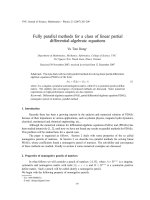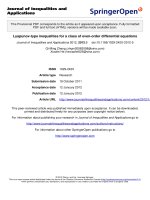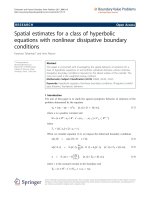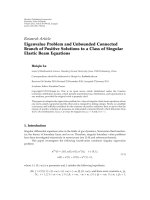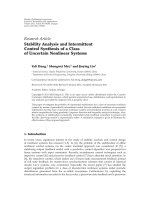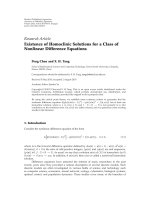ON A CLASS OF FOURTH-ORDER NONLINEAR DIFFERENCE EQUATIONS MAŁGORZATA MIGDA, ANNA MUSIELAK, AND EWA pptx
Bạn đang xem bản rút gọn của tài liệu. Xem và tải ngay bản đầy đủ của tài liệu tại đây (545.98 KB, 14 trang )
ON A CLASS OF FOURTH-ORDER NONLINEAR
DIFFERENCE EQUATIONS
MAŁGORZATA MIGDA, ANNA MUSIELAK, AND EWA SCHMEIDEL
Received 18 August 2003 and in revised form 22 October 2003
We consider a class of fourth-order nonlinear difference equations. The classification of
nonoscillatory solutions is given. Next, we divide the set of solutions of these equations
into two types: F+ - and F− -solutions. Relations between these types of solutions and their
nonoscillatory behavior are obtained. Necessary and sufficient conditions are obtained
for the difference equation to admit the existence of nonoscillatory solutions with special
asymptotic properties.
1. Introduction
Consider the difference equation
∆ an ∆ bn ∆ cn ∆yn
+ f n, yn = 0,
n ∈ N,
(1.1)
where N = {0,1,2,... }, ∆ is the forward difference operator defined by ∆yn = yn+1 − yn ,
and (an ), (bn ), and (cn ) are sequences of positive real numbers. Function f : N × R → R.
By a solution of (1.1) we mean a sequence (yn ) which satisfies (1.1) for n sufficiently large.
We consider only such solutions which are nontrivial for all large n. A solution of (1.1)
is called nonoscillatory if it is eventually positive or eventually negative. Otherwise it is
called oscillatory.
In the last few years there has been an increasing interest in the study of oscillatory
and asymptotic behavior of solutions of difference equations. Compared to second-order
difference equations, the study of higher-order equations, and in particular fourth-order
equations (see, e.g., [1, 2, 3, 4, 5, 6, 7, 8, 9, 10, 11, 12, 13, 14]), has received considerably less attention. An important special case of fourth-order difference equations is the
discrete version of the Schră dinger equation.
o
The purpose of this paper is to establish some necessary and sufficient conditions for
the existence of solutions of (1.1) with special asymptotic properties.
Throughout the rest of our investigations, one or several of the following assumptions
will be imposed:
Copyright © 2004 Hindawi Publishing Corporation
Advances in Difference Equations 2004:1 (2004) 23–36
2000 Mathematics Subject Classification: 39A10
URL: />
24
On a class of fourth-order nonlinear difference equations
(H1) ∞ 1 (1/ai ) = ∞ 1 (1/bi ) = ∞ 1 (1/ci ) = ∞;
i=
i=
i=
(H2) y f (n, y) > 0 for all y = 0 and n ∈ N;
(H3) the function f (n, y) is continuous on R for each fixed n ∈ N.
In [14] we can find the following existence theorem (some modification of Schauder’s
theorem) which will be used in this paper.
Lemma 1.1. Suppose Ω is a Banach space and K is a closed, bounded, and convex subset.
Suppose T is a continuous mapping such that T(K) is contained in K, and suppose that
T(K) is uniformly Cauchy. Then T has a fixed point in K.
2. Main results: existence of nonoscillatory solutions
In this section, we obtain necessary and sufficient conditions for the existence of nonoscillatory solutions of (1.1) with certain asymptotic properties. We start with the following
Lemma.
Lemma 2.1. Assume that (H1) and (H2) hold. Let (yn ) be an eventually positive solution of
(1.1). Then exactly one of the following statements holds for all sufficiently large n:
(i) yn > 0, ∆yn > 0, ∆(cn ∆yn ) > 0, and ∆(bn ∆(cn ∆yn )) > 0;
(ii) yn > 0, ∆yn > 0, ∆(cn ∆yn ) < 0, and ∆(bn ∆(cn ∆yn )) > 0.
Proof. Let (yn ) be an eventually positive solution of (1.1). Then, by assumption (H2),
(∆(an ∆(bn ∆(cn ∆yn )))) is eventually negative. Therefore, it is easy to see that the sequences
(an ∆(bn ∆(cn ∆yn ))), (bn ∆(cn ∆yn )), and (cn ∆yn ) are all monotone and of one sign, say for
n ≥ n1 .
Suppose that an2 ∆(bn2 ∆(cn2 ∆yn2 )) = −c1 < 0 for some n2 ≥ n1 . Hence,
an ∆ bn ∆ cn ∆yn
≤ −c1
for n ≥ n2 ,
(2.1)
c1
.
an
(2.2)
then
∆ bn ∆ cn ∆yn
≤−
Summing both sides of the last inequality from n2 to n − 1, we have
bn ∆ cn ∆yn − bn2 ∆ cn2 ∆yn2 ≤ −
n−1
c1
.
a
i=n2 i
(2.3)
−
Then bn ∆(cn ∆yn ) ≤ − n=n12 (c1 /ai ), which tends to −∞ as n → ∞.
i
Then there exists c2 > 0 and n3 ≥ n2 such that
bn ∆ cn ∆yn ≤ −c2 ,
for n ≥ n3 .
(2.4)
c2
.
bn
(2.5)
So,
∆ cn ∆yn ≤ −
Małgorzata Migda et al.
25
Summing both sides of the last inequality form n3 to n − 1, we obtain
cn ∆yn − cn3 ∆yn3 ≤ −
n−1
c2
,
b
i=n3 i
(2.6)
which tends to −∞, as n → ∞.
Then there exists c3 > 0 and n4 ≥ n3 such that (cn ∆yn ) ≤ −c3 , for n ≥ n4 . Hence,
−
∆yn ≤ −c3 /cn . A final summation yields yn − yn3 ≤ − n=n14 (1/ci ) → −∞, which implies
i
limn→∞ yn = −∞. This contradiction implies an ∆(bn ∆(cn ∆yn )) > 0 eventually.
Next, assume that there exists n5 ∈ N such that bn ∆(cn ∆yn ) < 0, for n ≥ n5 , then
(cn ∆yn ) must be eventually positive for otherwise we are again led to conclude that cn ∆yn
n−1
− cn3 ∆yn3 ≤ − i=n3 (c2 /bi ), limn→∞ yn = −∞. Thus, case (ii) is verified.
Next, suppose that bn ∆(cn ∆yn ) > 0 for all n ≥ n1 . Then bn ∆(cn ∆yn ) > bn1 ∆(cn1 ∆yn1 ) =
c4 > 0.
Divide the above inequality by bn and sum from n1 to n − 1 to get
cn ∆yn − cn1 ∆yn1 > c4
n−1
1
− ∞,
→
b
i=n1 i
(2.7)
as n → ∞. Hence, (∆yn ) is eventually positive.
Now we introduce an operator which divides the set of solutions of a special case of
(1.1) into two disjoint subsets. We will prove that, for nonoscillatory solution, the first of
them equals type (ii) solution and the second equals type (i) solution. We assume that
cn = an+1 . Hence (1.1) takes the form
∆ an ∆ bn ∆ an+1 ∆yn
= − f n, yn .
(2.8)
We introduce an operator as follows:
Fn = xn−1 an ∆ bn ∆ an+1 ∆xn
− an ∆xn−1
bn ∆ an+1 ∆xn .
(2.9)
Hence
∆Fn = xn ∆ an ∆ bn ∆an+1 ∆xn
− bn+1 ∆ an ∆xn−1 ∆(an+2 ∆xn+1 .
(2.10)
It is clear, by (H2), that the operator Fn is nonincreasing for every nonoscillatory solution
(yn ) of (2.8).
If Fn ≥ 0 for all n ∈ N, then a solution (yn ) of (2.8) is called an F+ -solution. If Fn < 0
for some n, then (yn ) is called an F− -solution.
The operator F divides the set of solutions of (2.8) into two disjoint subsets: F+ - and
F− -solutions.
Theorem 2.2. Assume that (bn ) is a bounded sequence. Let y be an F+ -solution of (2.8),
then
∞
bn+1 ∆ an ∆xn−1 ∆ an+2 ∆xn+1 < ∞,
(2.11)
n=1
lim bn ∆ an+1 ∆yn = 0.
n→∞
(2.12)
26
On a class of fourth-order nonlinear difference equations
Proof. Let (yn ) be an F+ -solution of (2.8). Then, from (2.8), we obtain
∆Fk = − yk f k, yk − bk+1 ∆ ak ∆yk−1 ∆ ak+2 ∆yk+1 .
(2.13)
By summation, we obtain
n−1
Fn = F1 −
n−1
yk f k, yk −
k=1
bk+1 ∆ ak ∆yk−1 ∆ ak+2 ∆yk+1 .
(2.14)
k=1
Since Fn ≥ 0, we have
n−1
bk+1 ∆ ak ∆yk−1 ∆ ak+2 ∆yk+1 ≤ F1 .
(2.15)
k=1
−1
Therefore n=1 bk+1 ∆(ak ∆yk−1 )∆(ak+2 ∆yk+1 ) < ∞.
k
Because (bn ) is a bounded sequence, then (1/bn ) is bounded away from zero. Hence,
from (2.11) and the equality
1
bn−1 ∆ an ∆yn−1
bn−1
bn+1 ∆ an+2 ∆yn+1 , (2.16)
lim bn−1 ∆ an ∆yn−1 = 0,
(2.17)
lim bn ∆ an+1 ∆yn = 0.
(2.18)
bn+1 ∆ an ∆yn−1 ∆ an+2 ∆yn+1 =
we obtain
n→∞
then
n→∞
Theorem 2.3. Assume that (bn ) is a bounded sequence. Every nonoscillatory solution (yn )
of (2.8) is an F+ -solution if and only if (yn ) is type (ii) solution.
Proof. We prove this theorem for an eventually positive solution.
Let (yn ) be an eventually positive F+ -solution. Suppose for the sake of contradiction
that it is type (i) solution.
Then from ∆(bn ∆(an+1 ∆yn )) > 0, we get bn ∆(an+1 ∆yn ) > bM ∆(aM+1 ∆yM ) > 0 for sufficiently large M and n > M.
This inequality contradicts condition (2.12) of Theorem 2.2. So, (yn ) is type (ii)
solution.
Let (yn ) be type (ii) solution. We will show the positivity of the operator F on the whole
sequence. Choose m sufficiently large. Then, from the definition of type (ii) solution,
we have Fn > 0 for n ≥ m. Because the operator F is nonincreasing, hence F j ≥ Fm > 0
for all j < m. Since m was taken arbitrary, then Fn > 0 for all n ∈ N. So, (yn ) is an F+ solution.
Remark 2.4. Assume that (bn ) is a bounded sequence. Then every nonoscillatory solution
of (2.8) is an F− -solution if and only if (yn ) is type (i) solution.
Małgorzata Migda et al.
27
Now we turn our attention to (1.1). We introduce the notation
n
Pn,N =
1
a
k=N+2 k
k
1
b
j =N+2 j
j
n−1
1
,
c
i=N+2 i
Qn,N =
1
c
k=N k
k−1
1
b
j =N j
j −1
1
.
a
i=N i
(2.19)
Note that Qn,N can be written in the form
n−1
Qn,N =
1
a
i=N i
n−1
1
b
j =i+1 j
n−1
1
.
c
k= j+1 k
(2.20)
Lemma 2.5. Assume conditions (H1) and (H2) hold. If (yn ) is an eventually positive solution
of (1.1), then there exist positive constants C1 and C2 and integer N such that
C1 ≤ yn ≤ C2 Qn,N ,
(2.21)
for n ≥ N + 3.
Proof. Let (yn ) be an eventually positive solution of (1.1). Then yn > 0 for large n. From
Lemma 1.1, ∆yn > 0 eventually, and so yn ≥ C1 > 0.
Now we prove the right-hand side of (2.21). From (1.1) and (H2), there exists N such
that
∆ an ∆ bn ∆ cn ∆yn
< 0,
for n ≥ N.
(2.22)
Summing the above inequality form N to n − 1, we get
∆ bn ∆ cn ∆yn
A0
,
an
for n ≥ N + 1,
(2.23)
1
+ bN ∆ cN ∆yN ,
ai
i=N
(2.24)
<
where A0 is a constant.
Summing again, we have
bn ∆ cn ∆y < A0
n−1
and therefore,
∆ cn ∆yn <
n−1
A0
1 A1
+ ,
bn i=N ai bn
for n ≥ N + 1.
(2.25)
Summing the last inequality, we obtain
cn ∆yn < A0
n−1
1
bj
j =N
where A1 and A2 are constants.
j −1
n−1
1
1
+ A1
+ A2 ,
ai
bj
j =1
l=N
n ≥ N + 2,
(2.26)
28
On a class of fourth-order nonlinear difference equations
Hence,
A
∆yn < 0
cn
n−1
1
bj
j =N
j −1
1 A1
+
ai cn
i=N
n−1
1 A2
+ .
b j cn
j =1
(2.27)
A final summation yields
n−1
yn < A0
1
c
k=N k
k
1
b
j =N j
j −1
n−1
1
1
+ A1
a
c
i=N i
k=N k
k−1
n−1
1
1
+ A2
+ A3 ,
b
c
j =N k
k=N k
n ≥ N + 3.
(2.28)
It is easy to see that every term on the right-hand side of the last inequality is less than
Qn,N . Therefore, we obtain yn ≤ C2 Qn,N for n ≥ N + 3, where C2 is a positive constant.
We say that a nonoscillatory solution (yn ) of (1.1) is asymptotically constant if there
exist some positive constant α such that yn → α and asymptotically Qn,N if there is some
positive constant β such that yn /Qn,N → β.
According to Lemma 2.5, we may regard an asymptotically constant solution as a
“minimal” solution, and an asymptotically Qn,N solution as a “maximal” solution.
Now, we present a necessary and sufficient condition for the existence of an asymptotically Qn,N solution.
Theorem 2.6. Assume that (H1), (H2), and (H3) hold and f is a nondecreasing function
in another argument, that is, “ f (n,t1) ≤ f (n,t2) for t1 < t2 and each fixed n.” Then a necessary and sufficient condition for (1.1) to have a solution (yn ) satisfying
lim
n→∞
yn
=β=0
Qn,N
(2.29)
is that
∞
f n,CQn,N
< ∞,
(2.30)
n=1
for some integer N ≥ 1 and some nonzero constant C.
Proof
Necessity. Let (yn ) be a nonoscillatory solution of (1.1) which satisfies (2.29). Without
loss of generality, we may assume that β > 0. Then there exist positive numbers d1 and d2
such that
d1 Qn,N ≤ yn ≤ d2 Qn,N ,
n ≥ N + 3,
(2.31)
where N is a sufficiently large integer. Then
f n, yn ≥ f n,d1 Qn .
(2.32)
Małgorzata Migda et al.
29
On the other hand, summing (1.1) from N to n − 1, and from Lemma 1.1, we get
0 < an ∆ bn ∆ cn ∆yn
= aN ∆ bN ∆ cN ∆yN
n−1
−
f i, yi ,
(2.33)
i=N
which implies that
∞
f i, yi ≤ aN ∆ bN ∆ cN ∆yN
< ∞.
(2.34)
i=N
So, by (2.32), we have
∞
f i,d1 Qi,N < ∞.
(2.35)
i=N
Sufficiency. Assume that (2.30) holds with C > 0 since a similar argument holds if C < 0.
Let N be large enough that
∞
1
f i,CQn,N < C.
8
i=N −3
(2.36)
Consider the Banach space BN of all real sequences y = (yn ) defined for n ≥ N + 3 such
that
yn
< ∞.
2
n≥N+3 Qn,N
y = sup
(2.37)
Let S be the subset of BN defined by
S=
y n ∈ BN :
C
Qn,N ≤ yn ≤ CQn,N , n ≥ N + 3 .
2
(2.38)
It is not difficult to see that S is a bounded, convex, and closed subset of BN .
We define a mapping T : S → BN as follows:
∞
(T y)n =
n−1
C
Qn,N + Qn,N
F(i) +
F( j − 1)Q j,N
2
i=n−1
j =N
n−1
j −1
i−1
1
+
ci
i=N
j =N
n−1
i−1
+
1
c
i=N i
F( j)
1
b
j =N j
k−1
1
1
bk s=N as
k=N
j −1
k−1
F(k + 1)
k=N
(2.39)
1
,
a
s=N s
for n ≥ N + 3,
where we have used the notation F(k) for denoting f (k − 2, y(k−2) ).
30
On a class of fourth-order nonlinear difference equations
We first show that T(S) ⊂ S. Indeed, if y ∈ S, it is clear from (2.39) that (T y)n ≥
(C/2)Qn,N for n ≥ N + 3. Furthermore, for n ≥ N + 3, we have
∞
(T y)n ≤
n−1
C
F(i) + Qn,N
F( j − 1)
Qn,N + Qn,N
2
i=n−1
j =N
n−1
+
i−1
k−1
1
1
1
ci k=N bk s=N as
i=N
n−1
1
+
ci
i=N
i−1
1
bj
j =N
j −1
i−1
F( j)
j =k+1
j −1
1
F(k + 1)
as k=s+1
s=N
∞
≤
(2.40)
∞
C
Qn,N + Qn,N
F(i + 2) + Qn,N
F( j + 2)
2
i=N −3
j =N −3
∞
∞
+ Qn,N
F( j + 2) + Qn,N
j =N −1
F(k + 2)
k=N
∞
≤
C
Qn,N + 4Qn,N
F(i + 2).
2
i=N −3
So, we have
∞
(T y)n ≤
C
Qn,N + 4Qn,N
f i, yi .
2
i=N −3
(2.41)
Therefore, by (2.36), we get
∞
(T y)n ≤
C
Qn,N + 4Qn,N
f i,CQi,N ≤ CQn,N .
2
i=N −3
(2.42)
Thus T maps S into itself.
Next we prove that T is continuous. Let (y (m) ) be a sequence in S such that y (m) → y
as m → ∞. Because S is closed, y ∈ S. Now, by (2.41), we get
∞
T y (m)
n − (T y)n ≤ 4Qn,N
i=N −3
f i, yi(m) − f i, yi ,
n ≥ N + 3,
(2.43)
and therefore,
T y (m)
n − (T y)n ≤
4
Qn,N
∞
i=N −3
f i, yi(m) − f i, yi .
(2.44)
Małgorzata Migda et al.
31
Since
lim f i, yi(m) − f i, yi
= 0,
m→∞
f i, yi(m) − f i, yi
≤ 2 f i,CQi,N ,
for i ≥ N + 3,
(2.45)
we see from Lebesgue’s dominated convergence theorem that
lim T y (m) − T y = 0.
(2.46)
m→∞
This means that T is continuous.
Finally, we need to show that T(S) is uniformly Cauchy. To see this, we have to show
that, given any > 0, there exists an integer N1 such that, for m > n > N1 ,
(T y)m (T y)n
− 2
< ,
2
Qm,N
Qn,N
(2.47)
for any y ∈ S. Indeed, by (2.41) and (2.36), we have
(T y)m (T y)n
C
8
− 2
≤
+
2
Qn,N Qn,N
Qm,N
Qn,N
∞
f i, yi ≤
i=N −3
2C
− 0.
→
Qn,N
(2.48)
Therefore, by Lemma 1.1, there exists y ∈ S such that yn = (T y)n , for n ≥ N + 3. It is easy
to see that (yn ) is a solution of (1.1). Furthermore, by Stolz’s theorem, we have
lim
n→∞
yn
∆yn
cn ∆yn
∆ cn ∆yn
= lim
= lim
= lim
n→∞ ∆Qn,N
n→∞ cn ∆Qn,N
n→∞ ∆ cn ∆Qn,N
Qn,N
= lim
n→∞
bn ∆ cn ∆yn
∆ bn ∆ cn ∆yn
= lim
−
n→∞
bn ∆ cn ∆Qn,N
∆ n=11 1/ai
i
= lim an ∆ bn ∆ cn ∆yn
n→∞
(2.49)
,
so,
∞
∞
yn
= lim C +
G(s) = lim C +
f i, yi
n→∞ Qn,N
n→∞
n→∞
s=n+2
s=n+2
lim
= C.
(2.50)
This completes the proof.
Theorem 2.6 extends [13, Theorem 1] and [14, Theorem 3].
Example 2.7. Consider the difference equation
∆
1
∆ (n − 1)∆ (n − 1)∆yn
n
+
1
yn 1/3 = 0,
n5/3 (n + 1)
for n ≥ 2.
(2.51)
32
On a class of fourth-order nonlinear difference equations
It is easy to calculate that Qn,N = (1/8)n(n + 1), n ≥ 4. Hence the above equation has a
solution (yn ) such that limn→∞ (yn /Qn,N ) = C = 0. In fact, yn = n2 is a solution of this
equation with limn→∞ (yn /Qn,N ) = 8.
Next we derive a necessary and sufficient condition for the existence of an asymptotically constant solution of (1.1).
Theorem 2.8. Assume that (H1), (H2), and (H3) hold and the function f is a monotonic
function in the second argument. Then a necessary and sufficient condition for (1.1) to have
a solution (yn ) which satisfies
lim yn = α = 0
(2.52)
Pi,N f (i,c) < ∞,
(2.53)
n→∞
is that
∞
i=1
for some integer N ≥ 1 and some nonzero constant c.
Proof
Necessity. Without loss of generality, we assume that (yn ) is an eventually positive solution of (1.1) such that
lim yn = α > 0.
n→∞
(2.54)
Then there exist positive constants d3 and d4 such that
d3 ≤ yn ≤ d4 ,
for large n.
(2.55)
Let zn = bn ∆(cn ∆yn ). It is clear that if condition (H1) is satisfied, then solution (yn ) of
(1.1) of type (i) tends to infinity. Since (yn ) satisfies condition (ii) of Lemma 2.1, hence
yn > 0, zn < 0, ∆yn > 0, and ∆zn > 0 eventually. Let N be so large that (2.55) and (ii) hold
for n ≥ N. We will use (1.1) in the following form:
∆ an−2 ∆zn−2 = − f n − 2, y(n−2) .
(2.56)
Multiplying the above equation by Pi−2,N −2 , and summing both sides of it from i = N to
n − 2, we obtain
n−2
n−2
Pi−2,N −2 f i − 2, y(i−2) = −
i=N
i=N
Pi−2,N −2 ∆ ai−2 ∆zi−2 .
(2.57)
Małgorzata Migda et al.
n−2
i=K yi ∆xi
Hence, by the formula
n−2
i=K xi+1 ∆yi ,
= xi yi |n−1 −
i=K
33
we get
n−2
Pi−2,N −2 f i − 2, y(i−2)
i=N
= −Pi−2,N −2 ai−2 ∆zi−2 |n−1 +
i=N
= −Pn−3,N −2 an−3 ∆zn−3 +
n−2
i−1
1
<
bj
i=N j =N
i−1
1
=
bj
j =N
n−2
1
=
bj
j =N
n−2
<−
1
zi−1
ck
k=N
n−1
i=N
j
1
a
i=N i−1
n−2
1
−
bi
i=N
n−2
1
1
zn−1 −
ck
bi
i=N
k=N
i−1
1
bj
j =N
j
1
ai−1 ∆zi−1
ck
k=N
i
1
∆zi
cj
j =N
i
1
bi ∆ ci ∆yi
cj
j =N
(2.58)
i
1
∆ ci ∆yi
c
j =N j
i
=−
∆Pi−2,N −2 ai−1 ∆zi−1
i=N
n−2
1
∆zi−1
ck
k=N
j
i=N
j
n−2
1
ci ∆yi
cj
j =N
n−1
i=N
n−2
+
∆yi+1
i=N
n−1
=−
1
cn−1 ∆yn−1 + ∆yN + ∆yn−1 + · · · + ∆yN+1
cj
j =N
< ∆yN + yn − yN+1 < ∆yN + yn ;
which tends to ∆yN + α as n → ∞. Therefore,
∞
Pi−2,N −2 f i − 2, y(i−2) < ∞.
(2.59)
i=N
From the monotonicity of the function f , we get
f i − 2, y(i−2) ≥ f i − 2,d3
(2.60)
f i − 2, y(i−2) ≥ f i − 2,d4
(2.61)
when f is nondecreasing and
when f is nonincreasing. This implies that
∞
Pi−2,N −2 f i − 2,dk < ∞,
i=1
(2.62)
34
On a class of fourth-order nonlinear difference equations
where k = 3 for f nondecreasing and k = 4 for f nonincreasing. Then the necessity of
this theorem holds.
Sufficiency. Next, let M ≥ 1 be a large integer such that, for some nonzero constant c,
∞
i=M Pi,M f (i,c) < α/4. From here,
∞
1
ci
i=M+2
∞
1
bj
j =i
∞
∞
1
α
f (s,c) < .
ak s=k
4
k= j
(2.63)
Here α = β/2 if f is nondecreasing and α = β when f is nonincreasing. Let B be the linear
space of a bounded real sequences (yn )∞ with the usual operations and supremum norm.
N
Let S be the subset
S=
yn ∈ B; α ≤ yn ≤ 2α, n ≥ M + 3 .
(2.64)
It is easy to see that S is a bounded, convex, and closed subset of B.
We define operator T in the following way:
n−1
∞
1
1
(T y)n = α +
cs k=n bk
s=M+2
n−1
∞
1
aj
j =k
k
∞
n−1
1
+
aj
j =M+2
n−1
j
f i, yi
i= j
∞
1
1
1
+
bk s=M+2 cs j =n a j
k=M+2
∞
f i, yi
i= j
k
(2.65)
∞
1
1
f i, yi
bk s=M+2 cs i=n
k=M+2
i
1
+
aj
i=M+2
j =M+2
j
k
1
1
f i, yi ,
bk s=M+2 cs
k=M+2
for n ≥ M + 3. It is easy to see that T maps S into itself. Indeed, if yn ∈ S, then (T y)n ≥ α.
Furthermore, for n ≥ M + 3, we have
n−1
1
cs
s=M+2
∞
1
bk
k=n
∞
1
aj
j =k
∞
∞
f i, yi ≤
i= j
∞
≤
n−1
k
1
1
bk s=M+2 cs
k=M+2
∞
1
aj
j =n
∞
i= j
∞
1
1
cs k=n bk
s=M+2
∞
1
1
c
b
s=M+2 s k=s k
n−1
1
f i, yi ≤
cs
s=M+2
n−1
≤
1
cs
s=M+2
∞
i= j
∞
∞
1
a
j =k j
n−1
1
bk
k=s
n−1
1
bk
k=s
It follows that (T y)n < α/4 + α/4 + α/4 + α/4 + α = 2α.
∞
1
aj
j =k
f i, yi
i= j
∞
1
aj
j =n
∞
1
aj
j =k
α
f i, yi < ,
4
(2.66)
∞
f i, yi
i= j
∞
i= j
α
f i, yi < .
4
Małgorzata Migda et al.
35
Next we assert that T is continuous. Let y (m) → y as m → ∞. We derive that
∞
(T y)n < α + 4
∞
∞
1
1
cs k=s bk
s=M+2
∞
1
aj
j =k
f i, yi
(2.67)
i= j
for n ≥ M + 3.
We obtain
∞
T y (m)
n − (T y)n < 4
∞
1
1
cs k=s bk
s=M+2
∞
−
1
aj
j =k
∞
1
1
cs k=s bk
s=M+2
∞
<4
∞
∞
1
1
cs k=s bk
s=M+2
∞
i= j
∞
1
aj
j =k
∞
∞
1
aj
j =k
i= j
f i, yi(m)
∞
f i, yn
(2.68)
i= j
f i, yi(m) − f i, yi .
Hence,
∞
T y (m) − T y ≤ 4
∞
1
1
c
b
s=M+2 s k=s k
∞
1
a
j =k j
∞
i= j
f i, yi(m) − f i, yi .
(2.69)
Since
lim f i, yi(m) − f i, yi
m→∞
f i, yi(m) − f i, yi
= 0,
≤ 2 f (i,C),
(2.70)
then, from Lebesgue’s dominated convergence theorem, we see that
lim T y (m) − T y = 0.
m→∞
(2.71)
This proves our assertion.
It is easy to see that T(S) is uniformly Cauchy.
Thus, by Lemma 1.1, the operator T has a fixed point in S. One can see that (yn ) is a
solution of (1.1) for all large n, then limn→∞ yn ∈ [α,2α] as required.
Theorem 2.8 extends [13, Theorem 2] and [14, Theorem 4].
Example 2.9. Consider the difference equation
∆ n∆ (n − 1)∆
1
(n − 1)
∆yn
+
27n3
yn 3 = 0,
(n + 4)(n + 3)(n + 2)(n + 1)(n − 1)3
(2.72)
for n ≥ 2. All assumptions of Theorem 2.8 are satisfied. Therefore, the above equation has
solution (yn ) such that limn→∞ yn = α = 0. In fact, yn = 1 − 1/n is such a solution.
36
On a class of fourth-order nonlinear difference equations
In conclusion, note that Theorems 2.6 and 2.8 can be easily extended to equations of
the form
∆ an ∆ bn ∆ cn ∆yn
+ f n, yδn = 0,
n ∈ N,
(2.73)
where δ is an integer-valued function defined on N such that limn→∞ δn = ∞.
References
[1]
[2]
[3]
[4]
[5]
[6]
[7]
[8]
[9]
[10]
[11]
[12]
[13]
[14]
S. S. Cheng, On a class of fourth-order linear recurrence equations, Int. J. Math. Math. Sci. 7
(1984), no. 1, 131–149.
J. R. Graef and E. Thandapani, Oscillatory and asymptotic behavior of fourth order nonlinear
delay difference equations, Fasc. Math. (2001), no. 31, 23–36.
J. W. Hooker and W. T. Patula, Growth and oscillation properties of solutions of a fourth order
linear difference equation, J. Austral. Math. Soc. Ser. B 26 (1985), no. 3, 310–328.
J. Popenda and E. Schmeidel, On the solutions of fourth order difference equations, Rocky Mountain J. Math. 25 (1995), no. 4, 1485–1499.
E. Schmeidel, Nonscillation and oscillation properties for fourth order nonlinear difference equations, New Progress in Difference Equations (B. Aulbach, S. Elaydi, and G. Ladas, eds.),
Taylor & Francis, London, 529–536, in press.
, Oscillation and nonoscillation theorems for fourth order difference equations, Rocky
Mountain J. Math. 33 (2003), no. 3, 1083–1094.
E. Schmeidel and B. Szmanda, Oscillatory and asymptotic behavior of certain difference equation,
Nonlinear Anal. 47 (2001), no. 7, 4731–4742.
B. Smith and W. E. Taylor Jr., Oscillatory and asymptotic behavior of certain fourth order difference equations, Rocky Mountain J. Math. 16 (1986), no. 2, 403–406.
, Oscillation properties of fourth order linear difference equations, Tamkang J. Math. 18
(1987), no. 4, 89–95.
W. E. Taylor Jr., Oscillation properties of fourth order difference equations, Portugal. Math. 45
(1988), no. 1, 105–114.
W. E. Taylor Jr. and M. Sun, Oscillation properties of nonlinear difference equations, Portugal.
Math. 52 (1995), no. 1, 15–24.
E. Thandapani and I. M. Arockiasamy, Oscillatory and asymptotic properties of solutions of nonlinear fourth order difference equations, Glas. Mat. Ser. III 37(57) (2002), no. 1, 119–131.
J. Yan and B. Liu, Oscillatory and asymptotic behaviour of fourth order nonlinear difference equations, Acta Math. Sinica (N.S.) 13 (1997), no. 1, 105–115.
B. G. Zhang and S. S. Cheng, On a class of nonlinear difference equations, J. Differ. Equations
Appl. 1 (1995), no. 4, 391–411.
´
Małgorzata Migda: Institute of Mathematics, Poznan University of Technology, ul. Piotrowo 3a,
´
60-695 Poznan, Poland
E-mail address:
´
Anna Musielak: Institute of Mathematics, Poznan University of Technology, ul. Piotrowo 3a,
´
60-695 Poznan, Poland
E-mail address:
´
Ewa Schmeidel: Institute of Mathematics, Poznan University of Technology, ul. Piotrowo 3a,
´
60-695 Poznan, Poland
E-mail address:
